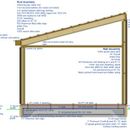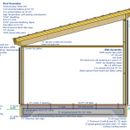Which assembly is better?
Assembly 1: Plywood Sheathing + Pro Clima membranes + interior rockwool
Assembly 2: Zip Sheathing + exterior EPS + interior rockwool
Assembly 1 uses (theoretically) higher quality components like plywood sheathing and Pro Clima membranes.
Assembly 2 has continuous exterior insulation which means better R values. There’s also less of a need to fuss with perfect membrane sealing.
I’m leaning toward assembly 2. Climate zone 4a. Any thoughts?
GBA Detail Library
A collection of one thousand construction details organized by climate and house part











Replies
Better by what metric? How will this building be used? Obviously the first one would cost less and have lower environmental impact; the second one has more insulation and would cost less to operate. But there is a lot of room for discussion between those observations.
I suppose I'm optimizing for cost/performance. It will be used as a small, conditioned woodworking workshop. I'm going to see if I can use reclaimed EPS if possible to lower the environmental impact. The second one actually comes pretty close in cost to the first one surprisingly.
In a small space like that, I would go with the least amount of insulation that does the job. The environmental impact of using new foam will never be recovered. One caution about using reclaimed EPS: I used to recommend it, but a client used it on the exterior of her new house and she found that its tendency to crumble left a lot of micro-plastics which will pollute the local environment.
Interesting, thanks for the heads up on reclaimed EPS. Maybe I'll see if I can find any rockwool comfortboard on Craigslist.
The biggest reason for so much exterior R value was trying to keep the sheathing warm to hit the required ratio for condensation. Adding rockwool to the stud bays and rafter bays adds ~7% to the project costs, but increases their R values by ~2.5x.
I am doing zip-R + Rockwool. Lot easier to manage the construction process. zone 5a